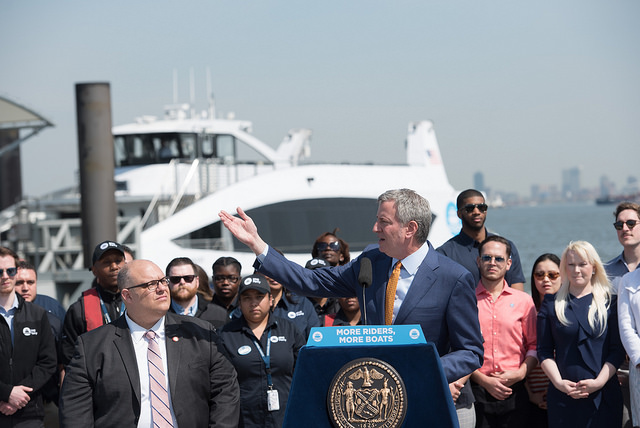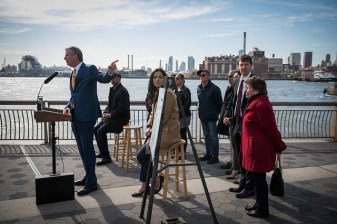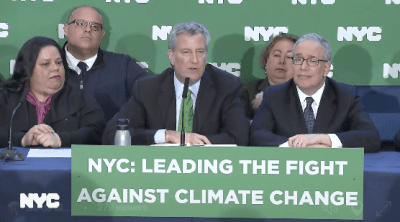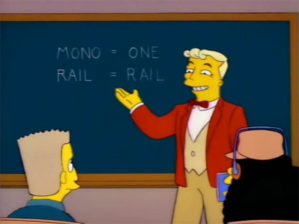De Blasio’s Ignorance of NYC’s Bus Crisis Shines Through at His Umpteenth Ferry Announcement
The mayor doesn't seem to know or care how he can reverse the dramatic decline of NYC bus service.

Ask Mayor de Blasio what he’s doing to address the city’s transportation challenges, and he’s likely to focus on one initiative in particular: the city-subsidized ferry service launched at a cost of hundreds of millions of dollars, which carried fewer than 10,000 trips per day in 2017.
The city’s bus system, meanwhile, carries about 2 million weekday trips but is hemorrhaging riders, and de Blasio has little to say about it.
Today de Blasio announced that he’s pouring more money into ferries, with another $300 million in capital spending on top of the $325 million his administration has already put into the system. The city also spends $30 million annually on ferry operations.
De Blasio’s press conference, at the just-opened Bay Ridge docks, was at least the eighth ferry-related public event he’s held since the beginning of 2017, compared to two such events for buses.
It’s not like the mayor has no control over bus service. As TransitCenter’s Tabitha Decker laid out in a recent Times opinion piece, it’s up to de Blasio to give buses priority at traffic lights, add more bus lanes, and keep cops from obstructing the bus lanes we already have.
Asked why the city has put hundreds of millions of dollars into the ferry system instead of bus service or Citi Bike, which get much more use, de Blasio said “each element of our mass transit planning has to be seen individually.” In contrast to buses and bike-share, de Blasio bizarrely claimed, ferry service “has tremendous long-term possibility.”
“Adding transportation options for millions of New Yorkers is a good thing,” the mayor said.
De Blasio is misinterpreting the numbers. If annual ferry trips are in the millions, that doesn’t translate to millions of New Yorkers. According to the city’s projection, by 2023 the ferry system will still have just 24,500 passengers per day, fewer than 14 individual MTA bus routes.
Many of those buses are in dire need of improvements that de Blasio could deliver, as TransitCenter noted on Twitter:
Some of the NYC bus routes that need bus lanes. Marked speed deterioration in peak periods, mostly operate on multi-lane streets:
Bx9: daily riders 27,175; speed 5.5mph; Turnaround grade D
Bx19: riders 31,531; 4.7mph; F
B41: riders 28,690; 5.9mph; Fhttps://t.co/St7abb3Ind
— TransitCenter (@TransitCenter) May 3, 2018
You could say there’s “tremendous long-term possibility” in speeding up bus service for hundreds of thousands of people, but the mayor of New York, where more people ride the bus than any other city in the nation, doesn’t see it that way. Maybe that’s because while ferries move fewer people than buses, unlike bus lanes, they don’t irritate motorists by claiming space from car traffic and parking.
It’s been 10 days since the MTA released its “bus action plan,” which has the potential to dramatically improve bus service citywide. For that to happen, de Blasio’s cooperation will be essential. Has the mayor given a moment’s thought to how he can prioritize buses on the streets?
“My broad understanding of the plan — I agree with it and we want to see more and better bus options,” he said.
Seemingly oblivious to the details of the action plan, which calls for applying measures citywide that have previously been rolled out one route at a time as part of the Select Bus Service program, de Blasio highlighted the city’s plan to add two SBS routes per year.
For the $600 million the city is spending on ferry capital needs, plus the $30 million annually in operations, the city could easily increase its expansion of bus lanes by a factor of five for a decade.
Asked whether the NYPD would effectively enforce bus lanes, de Blasio responded that “NYPD success rates at bus lane clearance is not one of the areas I’m an expert in” and declined to comment further.
From 2016 to 2017, citywide bus ridership dropped 6 percent — the highest year-over-year drop in 15 years — as bus speeds continued to fall. Millions of New Yorkers truly are affected by the abysmal state of bus service, but the mayor doesn’t seem to know or care how he can reverse this dramatic decline.




